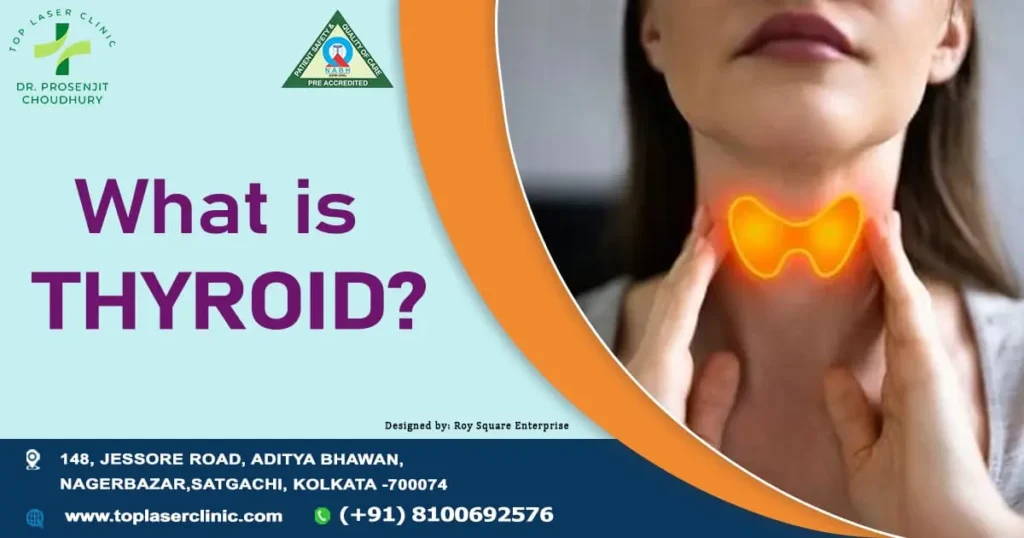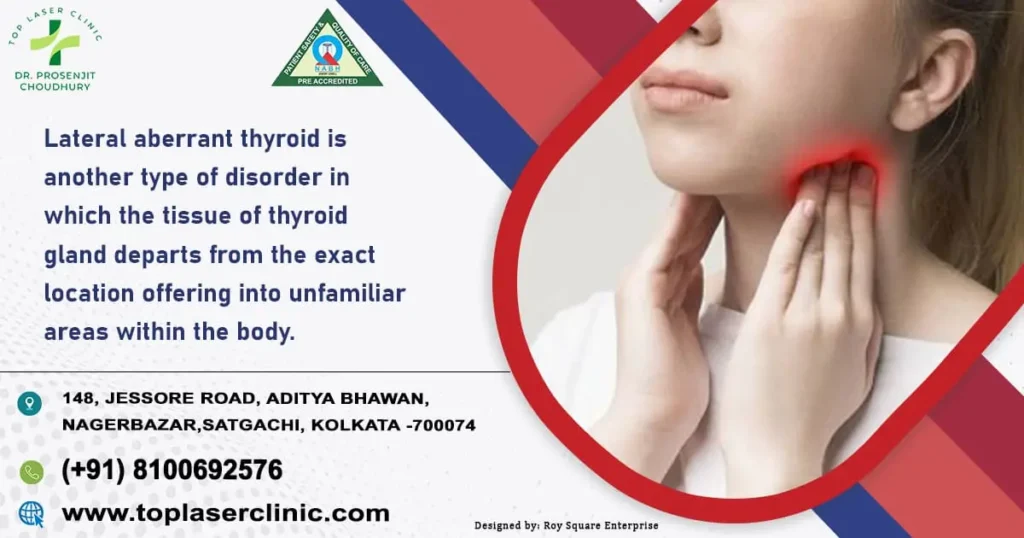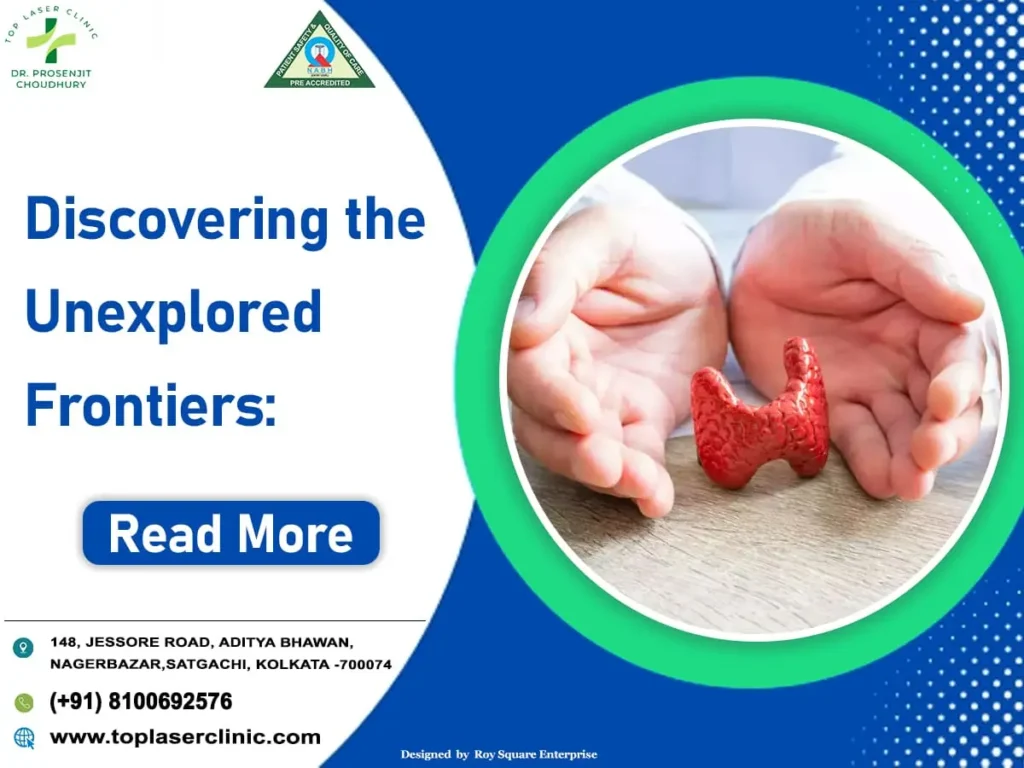Table of Contents

The thyroid gland is a very small yet powerful organ that is located in the front part of the human body. it plays a crucial role in the metabolic process of our body. In spite of having a tiny size, this butterfly-shaped gland holds a crucial role in human life. It regulates a large number of things that includes our energy level to our growth Understanding the thyroid and identifying its signs can allow individuals to seek timely medical care and retrieve their well-being.
What is the Thyroid?
At the junction of your neck, just underneath the Adam’s apple, lies the thyroid gland. This gentle gland, no larger than a walnut, composes a symphony of hormonal action that affects almost every cell in your body. Its key task is to Produce thyroxine (T4) and triiodothyronine (T3) hormones. These hormones act as metabolic organizers, leading the pace at which your body consumes energy.
In this blog post, we will shed light on different types of thyroid and their symptoms:
- Hyperthyroidism:
Consider your body as a car racing down the road of metabolism. In hyperthyroidism, it’s as though someone has blocked the accelerator device to the bottom. What the result can be? An outbreak of symptoms signifying a rev-up metabolic engine:
- Fast heartbeat (popularly known as tachycardia in medical term)
- Losing weight rapidly in spite of increased appetite
- A feeling of anxiety, nervousness or irritability without any specific reason
- Shakes in the hands and fingers
- Having difficulty in sleeping
- Heat intolerance to heat
- increased sweating
- irritable bowel movements or diarrhoea
- Fluctuations in menstrual patterns
- Exhaustion and weakness
- Increase of the thyroid gland (goitre)
B . Hypothyroidism:
On the other hand, in hypothyroidism, it’s as though the engine of your metabolism has taken a slow stop. The symptoms shows that the gland is not working at a portion of its capacity:
- Tiredness and weakness
- Gaining weight rapidly without any change of food habit and life style
- losing weight become quite challenging
- Intolerance to cold
- Constipation
- skin and hair become rough and dry
- losing Hair
- aches and weakness in muscle
- Depression
- Memory problems
- The menstrual period becomes irregular
Apart from these two popular types of thyroid, several other types of thyroid disorders are there. We will discuss their symptoms in the next segment.
C. Autoimmune Hypothyroidism or Hashimoto’s Thyroiditis
In this disorder, the patient will have the signs and symptoms of hypothyroidism as discussed in the previous section.
Apart from those, the signs are:
- Inflammation of the thyroid gland which is also known as goitre
- discomfort and stiffness in the throat
- Huskiness
- Trouble swallowing
D. Autoimmune Hyperthyroidism or Graves’ Disease
In this disorder, the patient will have the signs and symptoms of hyperthyroidism as discussed in the previous section.
Apart from those, the signs are:
a. Exophthalmos or Protruding eyes
b. Feeling of irritation in eyes
c. Eyes become sensitive to light
d. Changes in Vision
e. Double vision
f. Redness in eyes
g. Inflammation of the thyroid gland (goitre)
E. Thyroid Nodules:
This type of thyroid disorder remains asymptomatic in most case which means its shows no symptoms at all. In most cases, it is diagnosed while having an imaging test or a physical examination. It only shows symptoms in case they are quite large and compress the adjacent parts and patients find difficulty in breathing and swallowing.
F. Thyroid Cancer:
- Inflammation in the neck
- Discomfort in the neck or pain in throat that doesn’t leave
- Problem with swallowing and breathing
- changes in voice or Hoarseness
- Insistent cough but not due to a cold
- Growth in lymph nodes in the neck
Remember that these symptoms may vary from person to person depending on the type and stage of cancer.
Keep in mind that the signs we discussed above can vary among patients. It’s important to note that symptoms can vary widely among individuals, and some thyroid disorders may present with some disorders are even combined with other underlying diseases. As mentioned earlier, some of the thyroid disorders are even asymptomatic. So, if are suspecting that you having thyroid disorder and are showing one or some of the signs get in touch with the medical practitioner to restore this tiny gland in its original condition so that it can work perfectly.
The thyroid gland despite its tiny size has an immense impact on the intricate machinery of the human body. Whether it is cycling up your metabolic engine or reducing it to a crawl, thyroid disorders can significantly influence the quality of human life. By understanding the function of the thyroid and identifying its symptoms, one can take positive steps to get medical advice and restore health. Remember, human body is a precisely tuned instrument and thyroid is one of the most crucial organs that play a vital role in your well-being.
Lateral Aberrant Thyroid

Lateral aberrant thyroid is another type of disorder in which the tissue of thyroid gland departs from the exact location offering into unfamiliar areas within the body.
Understanding Lateral Aberrant Thyroid:
As discussed earlier, the thyroid gland is located in the front part of the neck and has a huge impact on the development growth and metabolism. In rare cases, the tissue of this gland stats changing position during early development and resulted in the unusual locations.
Manifestations and Diagnosis:
Detection of a lateral aberrant thyroid disorder is a diagnostic challenge. Signs, if present, can differ broadly depending on the position and functionality of the ectopic tissue. Some may experience intense masses or distress, while others may not show any sign, revealed incidentally during imaging studies or surgical procedures.
Finding often includes a mixture of clinical assessment and imaging modalities such as ultrasound, CT scans, or MRI. These tools provide insights into the structural differences and help define the aberrant tissue’s degree.
Clinical Implications and Management:
The existence of a lateral aberrant thyroid increases relevant clinical attentions. Functional irregularities, such as hypothyroidism or hyperthyroidism, may rise due to irregular hormone production. Moreover, the closeness of the ectopic tissue to dynamic structures postures clinical challenges and requires particular development to lessen risks.
Multi-corrective technique, including endocrinologists, radiologists, and surgeons are tha integral part of the management tactics. Different types of treatment options are available that range from from conventional procedures, including hormone replacement treatment, to surgical removal of the aberrant tissue, mostly in cases of compression or functional impairment.
Discovering the Unexplored Frontiers:

Apart from causing medical consequences, lateral aberrant thyroid represents the intricacy and a wide variety of features in the human body. Each case carries being unique, helping in further study in the understanding of the crucial connection between embryonic growth and physiological adaptation.
With the advancement of medical science and further research new outcomes are revealed that help to fight this complicated mechanism of the human body. Acceptance of these irregularities nurtures a deeper appreciation for the intricacies of human biology and emphasizes the uninterrupted quest for knowledge within the realm of medicine.